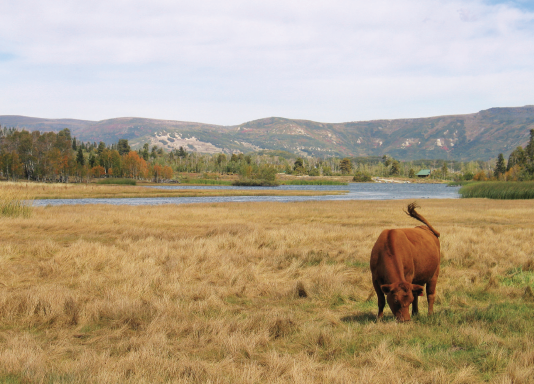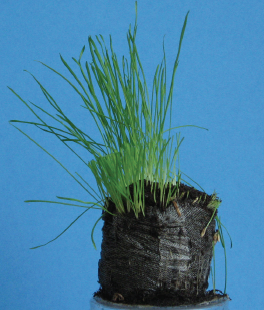Lesson Plan
At Home on the Range (Grades 6-8)
Grade Level
Purpose
Students investigate rangelands by growing their own grass to represent a beef or sheep ranch. Grades 6-8
Estimated Time
Materials Needed
Activity 1
- Jiffy 7 peat pellet pots,* 1 per student
- Plastic cups, 1 per student
- Permanent markers, 1 per group
- Grass seed,* 2–3 teaspoons per group
- Plastic spoons, 1 per group
- Trail activity sheets (laminate the sheets and provide each group with a transparency marker to save paper), 1 per group
- Transparency markers (such as Vis-a-Vis), 1 per group
- Water
*These items can be purchased in the Ranch Starter Kit from agclassroomstore.com.
Activity 2
- Water
- Scissors
Activity 3
Concept Elaboration and Evaluation
- Computer with internet access for each student
- Ridin' the Range Webquest
- Ridin' the Range Webquest Answer Key
Vocabulary
carrying capacity: the maximum number of animals a piece of land can support without degradation
open range: unfenced areas that can be grazed by livestock
rangeland: large, mostly unimproved section of land that is primarily used for grazing livestock
Background Agricultural Connections
What is rangeland?
When the term rangeland first came into use in the 1800s, it was used to describe the extensive, unforested lands dominating the western half of North America. Today, rangeland refers to a large, mostly unimproved section of land that is used for livestock grazing. Rangelands can be found in a wide variety of ecosystems, including natural grasslands, savannas, shrublands, deserts, tundras, alpine communities, coastal marshes, and wet meadows. Rangelands are usually mountainous, rocky, or dry areas that aren’t suitable for growing the usual farm crops. However, grass and other plants on this rangeland can be used for grazing livestock. People can’t eat grass but cattle and sheep can turn grass into beef and lamb.
As the human population continues to grow, more space is needed for neighborhoods, businesses, and the cultivation of crops. There are 1.8 billion acres in the United States. This is all the land available for homes, schools, airports, roads, farms, ranches, recreational areas, wildlife habitat, and everything else. Rangelands are important because they provide multiple goods and services and support many uses within the same space; they are multiple-use lands. Rangeland ecosystems provide nutritious forage for grazing livestock, which produce food, fiber, leather, and many other useful by-products. These same rangelands provide forage and habitat to wildlife (including many threatened and endangered species), numerous recreational opportunities, and a unique setting for social and cultural activities. We depend on these goods and services and expect them to be sustained for the benefit of future generations.
In order to use rangelands in all of these ways without damaging them, it is important that rangeland health be closely monitored and managed. So, who owns and manages rangelands? Ranchers may use their own private land to graze their animals or pay a fee to the government to lease public rangeland. Permits are issued by both the Forest Service and the Bureau of Land Management to allow grazing on public lands. Federal rangeland managers and private livestock owners work cooperatively to ensure that public rangelands are well cared for. Well managed grazing can be both economically and ecologically beneficial. Compared with harvested feeds like corn and wheat, range and pasture provide a relatively inexpensive feed source for livestock. Sales of livestock and other ranching activities contribute to the strength of local economies. Properly managed livestock grazing can also help keep grasslands healthy.
Rangeland management begins with grass. We tend to take grass for granted because there seems to be so much of it. In fact, there is a lot of grass. It is one of our most important and available renewable resources. Grass plays a number of environmentally important roles. Grass covers the soil and holds it in place, slowing runoff of rain, preventing erosion, and reducing the potential for floods. Grass traps and filters sediments and nutrients from runoff, and helps water percolate through the soil and back into streams and ground water.
Cattle and sheep are like rangeland lawn mowers that can help care for grassland ecosystems. Imagine what your lawn would look like if you didn’t mow it! At first glance when we see animals grazing, it seems like the animal wins all. However, there are more winners here than first meets the eye. The moment grass is shorn, it seeks to restore a balance between its roots and leaves. When the tops of the grass leaves are eaten by grazing livestock, the same amount of root is lost. When the roots die, the soil’s population of bacteria, fungi, and earthworms gets to work breaking down the dying roots. This creates fertile organic matter that enriches the soil.
Rich soils in turn support more grass growth. Grasses regrow from the bottom up. Because their growing point is low to the ground, grasses can usually recover well after grazing. However, repeated, heavy grazing can kill grass. When a grass plant is grazed very low to the ground, a large portion of its roots die, and it has little leaf area left to make energy through photosynthesis. Because the plant can’t generate much energy, it takes a long time for the roots to regrow, and the plant is very susceptible to drought. Proper management of grazing involves moving livestock to a new area before grasses are grazed too low and allowing grasses a period of rest to regrow leaves and roots before grazing them again. With proper management, grazing can be a tool for keeping rangelands healthy.
In well-managed grasslands, decaying roots are the biggest source of new organic matter, and grazing animals actually build new soil from the bottom up. In the absence of grazers, the soil-building process would be nowhere near as swift or productive. Grazing cattle aerate the soil with their hooves, scatter seeds, and trim wild grasses. Wildfires have a harder time taking hold on shorter, cropped grass than on longer vegetation. Properly grazed or “mowed” grass can help create healthy green grass!
Engage
- Show your students a picture of a rangeland and a cow grazing. Ask your students if they see anything in the picture that looks tasty for them to eat.
- Then, ask them if a sheep or cattle could find anything that is both tasty and nutritious to eat. No, humans do not have an adequate digestive system to obtain sufficient nutrients from grasses and other similar plants. However, cattle and sheep thrive grazing rangelands. In this lesson, students will learn how grazing can be managed to be a benefit to ranchers and to improve and maintain the health of the land.
Explore and Explain
Activity 1: Trail Blazing
- Review with your students the information found in the Background Agricultural Connections section of the lesson concerning rangelands, grazing, and the nature of grass.
- Divide your class into 6 groups. Each group will be taking a different “trail,” and on their way, they will start their own “ranch” with a small planting of grass.
- Note: Some of the "Trail" activity sheets will be most pertinent to Utah students, but the majority are generic and can be used by students in any state.
- Provide each student with a peat pellet and a plastic cup to hold it.
- Provide each group with a permanent marker, 2–3 teaspoons of grass seed in a small bowl, a plastic spoon, one of the Trail activity sheets, and a transparency marker.
- Ask students to place the peat pellet into the cup. Explain that you will be pouring 1/2 cup of water into each person’s cup while each group reads their Trail activity sheet, completes the activity, and then starts their ranch (plants their grass seed) by following the instructions in the sidebar of the Trail activity sheet.
- Instruct the students to begin working on the activity but to also observe their peat pellets. When they finish the activity, the water should be absorbed and the peat pellet completely hydrated. It takes about 15 minutes for the peat pellet to hydrate and expand into a pot in which seeds can be planted.
- When each group has completed their activity and all students have planted their grass seed, ask each group to share what they learned on their trail.
Activity 2: Grass and Grazing
- Once the seeds germinate, keep the peat pots moist, and allow the grass to grow until it has reached 2–3 inches in height. Students will be applying two different grazing treatments and will leave some of the grass untreated.
- When the grass is 2–3 inches tall, ask the students to use scissors to cut half of the grass blades short (1 inch) above the soil to simulate a cow grazing.
- They should clip another quarter of the grass down to the crown—where the blades meet the roots; this part of the blade is white in color. To simulate overgrazing, ask students to clip this quarter area to the crown every couple of days.
- The last quarter section of the grass should remain unclipped.
- Observe the grass for a few weeks, and then make comparisons. What are the results of the overgrazed, grazed, and ungrazed grasses? Ask students how their grazing experiment compares to mowing their grass.

Elaborate
Look up how many acres of rangeland your state has available. Is there a correlation between available rangelands and the quantity of livestock produced in your state? Use the Interactive Map Project website to identify the number of beef cows and sheep produced in your state. Beef cattle and sheep are the livestock species that are most commonly grazed on rangelands.
Evaluate
After conducting these activities, review and summarize the following key concepts:
- Rangelands can be public or private land. They are located in open spaces where there is grass and other grazing beneficial to livestock.
- Rangelands are generally not ideal for crop farming due to a variety of factors which can include rugged topography, limited water resources, etc.
- Rangelands are defined in part by their physical geography. Physical geography affects what plants and animals live in an area as well as what kinds of activities humans undertake in an area.
- Grazing rangelands can be beneficial to the environment if it is managed properly.
Recommended Companion Resources
- America's Heartland: Riding the Range on a Utah Cattle Drive
- America's Heartland: Wild & Wooly Roundup
- Beef Ag Mag
- Chew It Twice Poster
- Google Earth on the Range Repeat Photographs
- Illustrated Accounts of Moments in Agricultural History
- Little Joe
- NMSU Field Trip: Beef
- Ranch Starter Kit
- Sheep - Utah's Agricultural Cornerstone
- Sheepology: The Ultimate Encyclopedia
- TedTalk- How to Fight Desertification and Reverse Climate Change
- The Steaks Are High Online Game
- Tootsie Roll Conversation About Conservation Terms
- Utah Beefscapes
Author
Organization
| We welcome your feedback! If you have a question about this lesson or would like to report a broken link, please send us an email. If you have used this lesson and are willing to share your experience, we will provide you with a coupon code for 10% off your next purchase at AgClassroomStore. |
